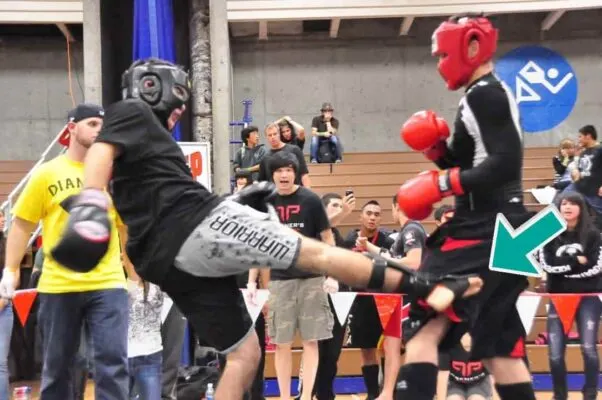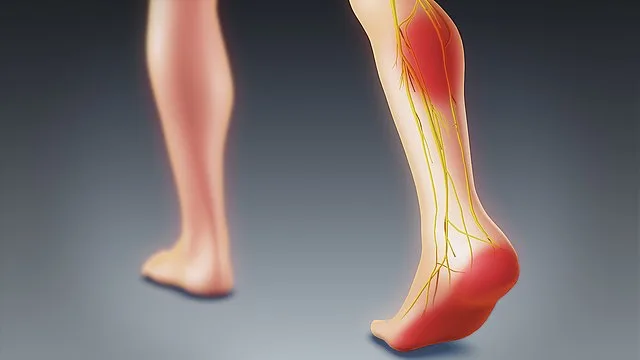
In modern times, low kicks have become one of the most effective techniques in freestyle combat, such as mixed martial arts (MMA) or GLORY kickboxing matches. But what is the secret behind the rise of low kicks, and why is this specific martial art technique so effective?
Low kicks are considered any leg kicks that strike below the waist of the opponent, primarily aimed at the thigh or calf. The goal is to kick the opponent with the shinbone (in Muay Thai) or foot (in karate) to damage their quadriceps or the sciatic nerve and impair their mobility.
Kicks with enough power and precision can easily finish the fight, as you can often see in MMA. We’ll help you understand the overall effectiveness of this kicking technique and what makes it so special.
What are Low Kicks?
Low-kicks are specific martial arts techniques designed to cause damage to the opponent’s legs. When executed with proper technique, low kicks can generate massive force, and if you manage to hit the right spot, you can easily finish the fight. Repeated kicks often result in damage to ligaments, muscle tissue, the sciatic nerve, joints, and bones.
The roots of low-kicking techniques are impossible to determine, as people have been kicking each other since the dawn of humankind. But in modern times, this technique has been popularized by martial arts such as Muay Thai, Kickboxing, and different forms of Karate. Each of these martial arts has its own variation of each kick, but the concept of low kicking remains the same.
For example, Muay Thai fighters tend to load up on each kick, throw them with their leg fully extended, and land with the shinbone. On the other hand, kickboxers bend their knees while throwing a kick and land with their foot. Further, Taekwondo and Karate have their own variations.
Low kicks are usually aimed at the opponent’s thigh or calf. Depending on the position and stances, there are two variations. First, you can throw them to the outside of the opponent’s leg or to the inside of the leg. See the images below for examples of both outside and inside low kicks.

Photo by superwebdeveloper

Inside low kick
Photo by Loura Conerney
In martial arts, a low kick is considered any kick that is thrown below the waist of the opponent. It is a low kick, whether it lands on the opponent’s thigh or ankle.
What Are the Different Types of Low Kicks?
Low-kicks play a big role in just about every martial art style. Whether it’s MMA, Muay Thai, or a Japanese martial art such as karate, low kicks are a crucial element of striking.
These fighting styles share many low-kicking techniques that look similar but also have their own variations. Here are some of the most popular:
Oblique kick
UFC champion Jon Jones is well known for using this kick. The motion of the kick is very similar to a stomp. However, the oblique kick is usually aimed at the opponent’s knee and thrown diagonally. Jon Jones explains the oblique kick more in detail in the following clip.
Roundhouse kick to the calf
The most popular low kick across all striking martial arts. Fighters would usually throw a hard roundhouse kick to hit the opponent’s calf right below the knee. Or they might target the other leg and hit the inside part of the calf.
Roundhouse kick to the thigh
A very effective and powerful kick. Fighters usually target the inside part of the thigh to cause damage and disrupt the opponent’s balance.
Sidekick
A common low-kicking technique. Since a sidekick generates a lot of force, fighters would use it to target the opponent’s knee.
Muay Thai vs. Kickboxing: How low kicks are landed differently
It’s worth pointing out that there is a difference in the way fighters throw low kicks and how they land them. Muay Thai fighters prefer fully extending their legs to generate massive force and land their kicks with their shins. Although these kicks are not like the ones in karate, for instance, each one carries enormous force.
Kickboxers prefer to throw their low kicks by lifting their leg, bending the knee at the half-point of the kick, and then hitting the opponent’s leg with their foot. The athletes trained in Taekwondo and different styles of karate also use a similar style.
RELATED: Muay Thai vs Kickboxing – Key Differences Explained and FAQ
How Effective Are Low Kicks In a Fight?
Low-kicks are very practical techniques for any type of freestyle combat. However, bear in mind that the overall effectiveness also depends on the type of situation you are in. Some self-defense scenarios, for example, won’t give you enough space to throw kicks.
The following examples illustrate why low kicks are very effective.
Keep the opponent at a distance and set up attacks
Low kicks are very effective at maintaining your range during the fight. Unlike high and spinning kicks, low kicks do not require as much time and energy to execute. Skilled fighters can throw them in the blink of an eye without much risk.
Opponents walking you down usually lean heavily on the lead leg, which you can target to disrupt their forward momentum and cause damage.
Low kicks are also a great way to create openings for other types of attacks, such as punches. Targeting the leg will likely force the opponent to drop their guard (hands) and expose their chin, which you can also attack.
Low kicks slow down the opponent’s movement
It’s unlikely that a single-leg kick will finish the fight for many fighters. However, repeated leg strikes can significantly slow the opponent’s movement. This is notably effective if your opponent’s style relies heavily on footwork. After absorbing a couple of hard kicks at the same spot, their leg will start to swell and feel numb at some point.
They will no longer have the same feeling, impacting how they move and throw strikes. When your leg is damaged, it throws off your balance, timing, reactions, and the way you punch or kick.
The best example of this was when Dustin Poirier damaged Conor McGregor’s lead leg with hard calf kicks in their second fight (UFC 257). McGregor, whose primary skillset is boxing along with a heavy dependence on his lead leg movement, couldn’t move well or strike well after getting kicked in the calf over and over again. He became a sitting duck, which led to his demise in the fight. See the fight clip below.
Can easily immobilize legs during the fight
A well-placed leg kick can also cause nerve damage; when this happens, it’s usually game over. First, a leg kick can damage the famous sciatic nerve, the longest nerve in the human body, which goes from your spine all the way down to your foot.
A low kick can be very effective at disturbing this nerve during the fight because the sciatic nerve has little to no muscle protection in the lower part of the leg. You can immobilize your opponent’s leg by repeatedly kicking the correct spot.

Credit: scientificanimations.com
The next is the peroneal nerve, located just above the knee. This nerve can get damaged if a person absorbs a couple of hard low kicks to the exterior part of the knee toward the back of the leg. The damage usually results in a temporary loss of motor control of the leg, pain, and numbness.
RELATED: What Are Liver Shots In Combat Sports/MMA?
What Are the Risks of Throwing Low Kicks?
Although low kicks are a very effective strategy, this technique also comes with some potential risks. Here are some of the risks associated with throwing low kicks in a fight:
Knee injuries
Throwing repeated leg kicks puts a lot of stress on the knee joint. This can lead to chronic pain, inflammation, or more severe injuries such as a torn ligament or meniscus. To prevent this, fighters who rely heavily on leg kicks must spend a lot of time enhancing their knees’ strength with different exercises.
Shin injuries
Shin injuries are common in Muay Thai, where fighters land kicks with their shin bones (tibia). If the shin bone is not strong enough, a well-placed low kick could cause it to break. This happened to Anderson Silva at UFC 168 against Chris Weidman. At one moment, Weidman perfectly timed the low kick, which resulted in Silva breaking his shin bone in half.
Foot injuries
Foot injuries are common in martial arts such as kickboxing, which involves landing low kicks with the foot. In most cases, fighters sustain minor or severe injuries when they hit the opponent’s knee instead of the calf or thigh. This can result in sprains, torn ligaments, or foot fractures.
Leaves you open for counterattacks
In order to throw a leg kick, you have to put yourself off balance or out of position for a brief moment. If you telegraph the attack and the opponent sees it coming, they can easily catch you with the counterattack. They might catch you with the punches or, as in MMA, change their levels and take you down to the ground.
How Do Fighters Defend Against Low Kicks?
The most common way is by checking the kick or moving away. Here is a detailed explanation of all the methods.
- Checking the kick—includes lifting your leg, slightly turning it towards the upcoming kick, and blocking the kick with your knee or shinbone. The opponent is targeting the soft parts of the calf and thigh. So checking your opponent’s low kick with the hard surface of your knee or shinbone causes huge pain to your opponent and may result in a bone fracture upon impact.
- Catching the kick — is also a common way to defend against low kicks. This method requires solid timing and skill but is very effective as catching the leg enables you to take the opponent down or counterattack with kicks and punches.
- Moving away — involves you stepping back or angling out to the side to avoid the low kick. As with catching the kick, this method requires timing and high spatial awareness.
Are Leg Kicks Effective in Street Fights?
Leg kicks can be an effective technique in self-defense situations. When timed and placed correctly, these strikes can cause damage to the opponent’s legs and limit their mobility. However, the overall effectiveness is based on many factors, such as the place of the fight. There are scenarios where you won’t have enough space to throw a kick, such as in a crowded bar, for instance.
This technique is notably effective against people not trained in martial arts. These people have never felt the power of a kick, nor do they know how to check low kicks correctly. No matter how strong they are, just a single, well-placed kick can drop an average person down to the ground. For instance, some Thai boxers can generate great power in a kick, similar to hitting someone with a baseball bat. Leg kicks can be an effective technique in a self-defense situation. Now imagine an average person receiving such a strike from a well-trained kickboxer.
Overall, leg kicks are very effective in street fighting scenarios where you have enough space to move around. But you can’t rely solely on this technique in a self-defense scenario. Low kicks aren’t some magical technique that works in all self-defense situations. Low kicks can be a very effective arsenal when you mix them with punches, head movement, and footwork to defend yourself.
How Fighters Train to Throw Low Kicks
Fighters improve their leg-kicking skills by focusing on developing proper technique and increasing flexibility and strength. Following is a detailed explanation:
- Stretching exercises — enable you to increase flexibility and range of motion. You can’t expect to throw hard leg kicks the right way without having flexible hips for example. As a result, students perform different dynamic and static stretches before and after each workout.
- Strength training — involves doing specific workouts that increase the leg muscles such as leg presses, squats, and lunges. These exercises increase the strength and power of the leg muscles, which enables you to throw harder kicks as well as to absorb the punishment.
- Heavy bag workouts — are crucial when it comes to drilling specific low-kicking techniques. Throwing hundreds of kicks enables them to develop proper technique, stamp the motion of the kick deep into their muscle memory, and condition their legs to withstand the impact of the strike.
- Sparring — is one of the most effective methods to learn how to apply low kicks in a fight. Knowing the correct motion of the kick is great. But you need to practice this technique against the fully resisting opponent in sparring on a regular basis to learn how to use it in a fight.
- Shin bone conditioning—the objective is to harden the shin bone like stone, making a low kick more damaging when you kick your opponent’s leg. In order to strengthen their shin bones, some Muay Thai fighters kick banana trees with their shins. But most fighters kick a punching bag or a padded wooden dummy instead.
Are Low Kicks Used in All Kickboxing Styles?
Different styles of kickboxing, including Muay Thai, Japanese Karate, and Taekwondo, utilize both high and low kicks.
However, competitions in American kickboxing (full-contact kickboxing) do not allow kicks below the waist. This variation emerged in the 1970s, putting more emphasis on punches (western boxing) and high kicks above the waist.
Who Has Popularized Low Kicks in Combat Sports?
As different martial arts transitioned into mainstream sports, many great fighters used low kicks as their signature move to win fights, popularizing this specific technique.
Maurice Smith — is a former kickboxer who put kickboxing on the map in UFC fights. In his career, he utilized low kicks to finish many of his opponents, such as Bill Morrison, Raymond Horsey, and Travis Everett.
Marco Ruas — is one of the best leg kickers in the history of MMA. The best display of his leg-kicking technique was in his match against Paul Varelans at UFC 7. Ruas repeatedly landed devastating Muay Thai leg kicks onto Varelans’ huge thighs until he couldn’t handle it anymore.
Rob Kaman — is also known as “Mr. Low Kick”. This Dutchman is a true pioneer of modern kickboxing, and the man is synonymous with leg kicks in combat sports.
Some other well-known athletes who used low kicks to a great extent in combat sports are:
- Jose Aldo
- Antoni Hardonk
- Pat Barry
- Mauricio “Shogun” Rua
The Final Say: Why Low Kicks are One of the Best Kicks
Learning how to throw a low kick is very simple. And the simplicity mixed with speed is what makes this technique so practical in every form of fighting. On top of that, low kicks do not require as much energy or a high level of athleticism to execute as other kicks do, as you often see in fancy Taekwondo kicks.
